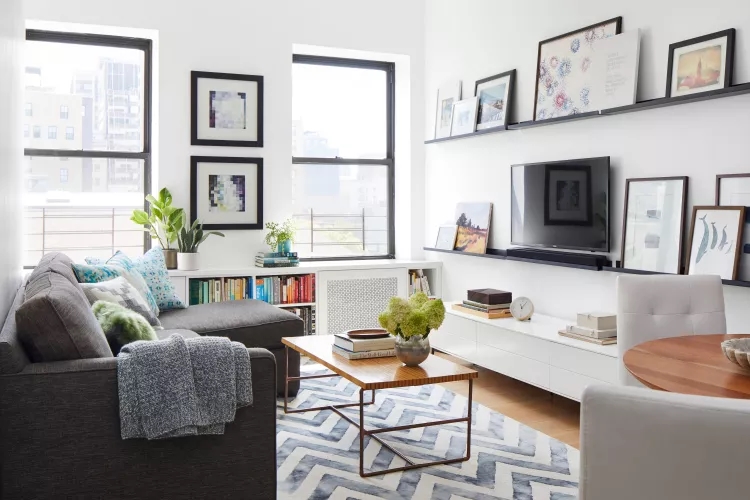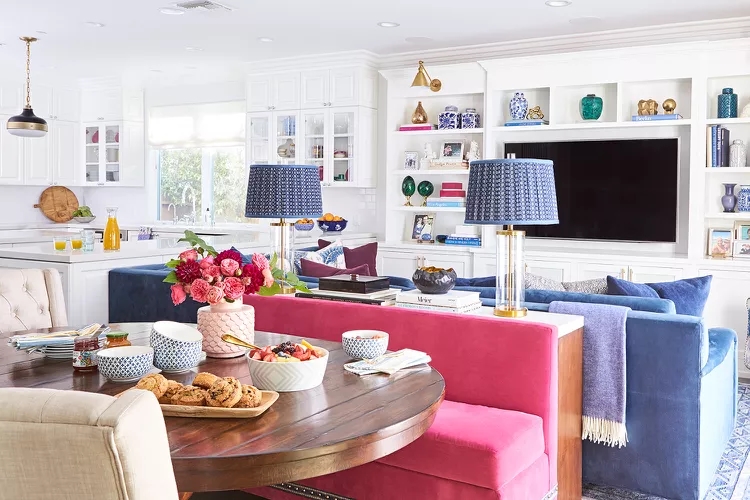
Wishing for a design focal point other than a jet-black television? We have solutions.
While televisions are a feature in many households, it can be challenging to incorporate them in an attractive way. Luckily, today’s flat-screens have come a long way from their boxy counterparts of the past, which is good news, as it makes accomplishing this design task possible.
Ahead, we explore a few sneaky ways to give your TV a stylish hideout in every room of the house, including living rooms, bedrooms, and even outdoors.
1. Frame Your TV
Consider turning your TV into framed art. For example, FrameMyTv.com provides custom television frames (exclusively for Samsung The Frame) that run the gamut from ornate gold to contemporary white wood. There are also custom framing options on the market compatible with various TV brands, so research your unique needs to ensure a high-quality result and fit.
2. Invest in “Designer” TVs
Samsung’s The Frame is a popular television option for design enthusiasts. With a matte display and customizable bezels, this TV looks like a real piece of art. Its art mode allows you to display art and personal photos on a digital carousel display. And the TV itself can even flip between both landscape and portrait orientations. You can even subscribe to Samsung’s art store to access a library of more than 2,000 pieces of artowrk. Samsung also makes the Serif TV, designed by French design experts Ronan and Erwan Bouroullec. This unit comes with a detachable stand giving you the freedom to move it to any room in the house.
Another option is Sony’s A8H series, which features a similar art-like aesthetic, flaunting a thin frame and bezel plus a top-contrast OLED display. But what makes this piece unique is its no-gap design, resulting in a TV that sits flush with your wall—just like a real piece of artwork.
3. Build a Sliding Mechanism
If you’re DIY savvy, install sliding doors on your storage unit to conceal your TV, or hire a carpenter to take the lead. Based on your space’s architectural elements, size, and shape, a carpenter can design a bespoke solution for you. Whether you want cabinets to surround your TV or mesh doors to accommodate a sound system, be sure to consult on all design possibilities in the planning stage.
4. Choose a Floating Entertainment Center
If investing in a new TV isn’t an option, try changing the background of your TV instead. A floating entertainment center can do the trick, freeing up horizontal real estate and creating a sleek aesthetic. Some floating media centers even come fully equipped with storage to conceal all your digital gizmos and gadgets.
PRO TIP:
For inspiration, look to Pinterest, where you’ll find several styles, shapes, and sizes of TV units that camouflage a TV well. For example, some floating entertainment centers have tall frames with open cubbies while others flaunt a simplistic design that closely surrounds the TV. A few search terms that may help narrow down your choices: floating entertainment centers, floating TV consoles, floating TV centers with paneled wall, and DIY floating entertainment units.
 5. Incorporate a TV into a Gallery Wall or Decorative Grouping
5. Incorporate a TV into a Gallery Wall or Decorative Grouping
Use your TV to anchor a cluster of artwork, sculptures, or framed photos. This will make an event out of a blank space and form a unifying backdrop for your TV. You can also disguise your TV by installing floating shelves and featuring it within a grouping. Top your shelves with collectibles, vases, or leaning art. If you’re a minimalist or someone who prefers a clean backdrop for your TV, this may not be the best design approach for you.
6. Hide a TV in Wall-Mount Cabinets
For a tidier approach, try a wall-mounted TV cabinet. With hundreds of iterations on the market (and some you can even DIY if you’re handy), these storage staples make for a nifty TV-hiding solution. Take, for example, this version from Suzanne Kasler’s collaboration with Ballard Designs. With hardwood construction and glass panels, the TV cabinet allows you to display your own printed art or sheets of fine-art paper.
 7. Balance a TV with Built-Ins
7. Balance a TV with Built-Ins
Built-in bookshelves will never date your space. Plus, these storage and display units take up less square footage than traditional furniture and can be squeezed into even the most oddly-shaped nooks. If budget allows, partner with a carpenter to design a wall of built-in bookshelves for your TV. Complete the TV center with a custom cover and beautiful millwork.
PRO TIP: If you have the budget to design your own built-ins, thoroughly think through their functionality. Which clever features can you add that would assist your daily living? Maybe that’s built-in storage for toys, slots for sewing and crafts supplies, or mesh cabinetry to allow for speakers.
8. Make It Part of Your Accent Wall
Accent walls are also a tried-and-true design method that blend a TV right in, create a focal point, and dress up a bare wall. To create your own accent wall — either dip it in a bold hue or install custom paneling (or both). Paneling is a creative option worth exploring as the options almost feel limitless—ranging from horizontal stripes, double-raised, perfect grids, and more! By using this design solution, your accent wall will take centerstage (versus your TV becoming your only focal point).
9. Buy a Media Center with Doors
An easy, unfussy way to conceal a TV is to simply buy a TV cabinet, such as this two-piece unit from Crate and Barrel. Perfect for a living room, family room, bedroom, study, or den, this versatile piece comes with two storage drawers, bi-fold doors, and cord management cutouts. Or opt for a media center with sliding barn doors, which allow you to both showcase decor and hide your TV when not in use.
10. Explore Unconventional Options
If you’re feeling a bit adventurous, try exploring an out-of-the-box solution, whether a TV mirror, TV lift cabinets, or even a motorized TV cover. And for times when you’d rather just forego your TV altogether, try portable TV tablets, like this one from LG, or a rollable screen with a projector setup. Rollable screens can be a great alternative to a traditional TV because they allow you to leave your wall as-is and roll down the screen only when you’re viewing content. While some of these options may require professional installation, others are simple plug-in-and-play setups.
Shivani Vyas, Better Homes & Gardens

